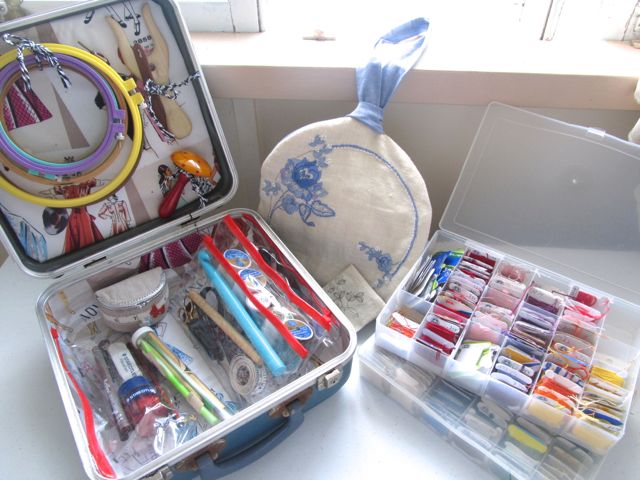Tuesday, May 10, 2016
Organizing and Storage - Lesson Ten Embroidery School
Congratulations! You have done a great job here in Embroidery School. You've transferred a design, chosen thread colors, learned twelve stitches, and framed or mounted your work. "Time to clean up!"
Uh, oh. How on earth to store supplies accessibly and neatly, and maybe even portably so you can take your work wherever you have to go and still have YOU time.
You know, that completely enjoyable unplugged time at the cafe, or during that hour in the dentist's waiting room, or the not-in-the-mood-for-TV-or-a-book personal time, or the please-take-this-phone-out-of-my-hands time.
Embroidery is a great method of retrieving YOU time from the over-busy, over-buzzing, over-beeping, over-spending mode of being we sometimes fall into.
In order to enjoy it again and again, there has to be a way to design a storage system that doesn't take up half the dining table or get lost in a box somewhere in the back of the hall closet.
First, here's a little look-see of my set-up and below is a link to a collection of ideas for truly awesome storage and organization systems.
Except for fabric, drawing and tracing paper, and my iron, this is actually all I use for embroidery. And this includes my YOU Time Embroidery Tote for taking my work anywhere and storing it between stitching sessions. The sewing pattern for it is free and downloadable.
The larger version of what I need to store includes a place to do the ironing and shows fabric on a roll and freezer paper for printing my patterns.
My studio is not the height of coolness. But it magnificently serves my love of low-tech simplicity and my need for portability as I am, what I call, fatally nomadic. I move a lot, and I don't often have a separate room for sewing and stitchery.
Generally, these are the things that need storage solutions:
Basic sewing supplies - needles, sewing thread, pins, scissors, measuring tapes, iron and ironing board or pad
Basic drawing supplies - paper, tracing paper, pens, pencils, sharpener, eraser
Embroidery supplies - embroidery threads/floss, hoops, fabric
Basic work space needs - table and chair, lamp and/or good natural light
Other items that help if you share or blog about it - printer, freezer paper, computer, back-up drive, camera and battery charger
Craving simplicity
It used to be that a couple of tins of threads and sewing supplies was enough for a stitcher. Now we've made it so complicated with dissolving fabric, special pens, and "the stash" which can be a monster in and of itself.
I have learned over my 50 years of stitching and needlework, that if you are having trouble organizing your supplies, you probably have too many supplies. And that really takes the fun out of being able to enjoy some quiet, or even shared, time embroidering.
The very bottom line of embroidery storage is going to be needles, scissors, fabric, and threads/floss. Embroidery threads or floss is the main one.
Threads and floss
You know those absolutely gorgeous photos of embroidery floss in perfect rows in storage boxes? This isn't one of those. This is reality. These are my two boxes and the mess I need to wind onto bobbins this week.
Once I've separated the strands and had to rewrap the remainder back on the bobbin, there are always loose bits.
Which brings me to my first and only rule regarding embroidery floss storage:
No, it's not a life-or-death issue, but it is a big-time sanity preserver and worth following.
Needles
Needles are easily lost and sometimes not so easily found, but they are definitely easily taken care of.
Keep needles in a magnetized tin, needle case or pincushion.
If you use or make a pincushion, it is recommended that it is filled with natural wool rather than plastic fibers. Even washed wool has enough lanolin to keep needles smooth and rust-free. A small emery or super-fine sand filled pincushion keeps needles sharp.
If you make or buy a needle case, make sure the felt is wool.
Sourcing wool from local folks is not difficult. You don't need much and if you tell them what you want it for, they are likely to just give you a few handfuls for your pincushions. If not, it's not too expensive to buy just a little.
There are several sources for wool fleece in the Source Sew-pplies tab at the top of the page.
Now for the crazy cool links!
I've started a Pinterest board for embroidery floss storage. These are some of my favorites and the links for these are on the board.
There's no one way to organize that's best. It just has to work for you.
There are also lots of cool links to bobbin patterns and printables for making your own. My favorite is the standard DMC cardboard bobbin. It's the one with DMC printed on it. It is thicker than most so it's sturdy and reusable. It's non-plastic which I prefer. And they have the little hole in the top so they can be used on a ring which is great for taking with you when you just need the colors you want for the project you are working on.
Which is exactly the subject of tomorrow's post - taking your stitching wherever you go. It's the last post in this series of Embroidery School. And then we'll have a stitchery graduation party!
Want to catch up on all the lessons in Embroidery School? Click right here! This will take you to the Embroidery School page - same as the tab under the blog banner.
Want to stay in touch? Sign up for the weekly newsletter, receive news, promotions, and a spiffy free embroidery pattern.
Subscribe to:
Post Comments (Atom)









No comments:
Post a Comment